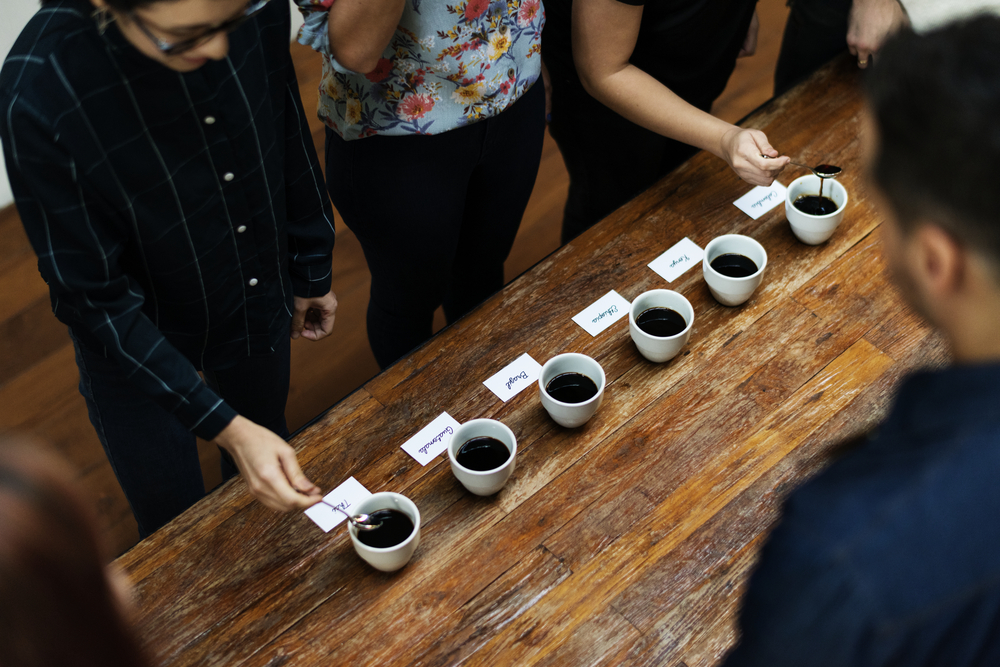Priming your palate | How to get better at coffee tasting

As published in BeanScene Magazine
Despite what you may think, anyone can learn to become a better taster and assess coffee like a pro. We all know that taste is subjective. What you may not realise though is that you can train your palate and become a more discerning taster. This ability to pick up subtle differences in taste – and to define them – is a worthwhile endeavour, whether you are a coffee professional or a home barista. If you work in the coffee industry, developing your palate is a necessary skill. It will help you get the best out of your machine, and your coffee. It will also assist you in selecting the right coffee and roasts for your customers.
For example, a dark roast makes the flavour of a coffee more homogenous, hence the trend towards lighter roasts and their increased complexity, to match the increasing sophistication of coffee consumers’ tastes.
Even if you are just looking to indulge your passion for coffee at home, tasting is a worthwhile activity which will heighten your enjoyment of coffee. The taste of a coffee and the accompanying adjectives used to describe it will vary depending on the region
and type of coffee, and how it’s been roasted. With a bit of practice, you can expand and educate your palate and learn to recognise the taste qualities of the many coffee origins, of which there are over 50. Some of the differences in how coffees taste are obvious and easy to recognise and others are more subtle. Just keep in mind that coffee tasting is like any other skill – the more you do it, the better you will become.
From drinking to coffee tasting
While we’re all familiar with wine-tasting, the ability to taste coffee in a similar manner is not as familiar ground as a culinary pursuit. There’s a lot to explore in coffee though, with its 800 flavour compounds, which makes it twice as complex as wine.
Cupping, which is the method used to seek out the defects in a coffee, was created as a way to discover more about the raw material before purchase. Although cupping was designed for commercial purposes, we can learn from the measured, conscious tasting employed by cuppers – even if we are tasting purely for pleasure.
The main steps to tasting are simple: tasting and smelling. The flavour of a coffee is actually a combination of taste and smell. The olfactory plays a huge part in the taste experience, just as it does in wine-tasting.
‘Good’ versus ‘bad’ coffee
Taste being the subjective sense that it is, is there a way of picking out good coffee from bad? There is no definitive answer here, but we can say that certain characteristics of coffee are regarded as positive attributes, and contribute towards a coffee’s quality level. For example, the taste characteristic of acidity, or brightness, is preferable to flat, or lacking in acidity.
A great way to begin your tasting journey is to learn to identify stale versus fresh coffee. This demonstrates that although taste is highly subjective, there are indeed certain characteristics that most coffee drinkers would identify as desirable – freshness being a primary one.
Taste basics
The main categories used to help describe and define coffee taste are: aroma, acidity, body, flavour and aftertaste.
Aroma – Our sense of smell is critical to the enjoyment and evaluation of coffee and adds more dimensions to the basic capabilities of our taste buds. As the most diverse element in coffee, aroma gives each coffee its unique signature. It’s our ability to smell the aroma of coffee that enables us to go beyond the four basic taste sensations of sweet, sour, salty and bitter. Aroma adds the many interesting and subtle nuances of flavour such as ‘nutty’, ‘spicy’, or ‘fruity’.
Acidity – This very desirable coffee characteristic is often mistakenly viewed as a negative trait. Acidity in coffee translates to brightness, liveliness or vibrancy, and results in a sharp, pleasing aftertaste. Coffee lacking in acidity is undesirable, and is often described as flat.
Body – A characteristic which refers to the texture of the coffee and the sensation in your mouth, rather than the flavour. Also referred to as ‘mouthfeel’, body comes from the coffee oils that are extracted during the brewing process. Full-bodied coffee is often described as rich, or heavy, and a thin and watery coffee is said to lack body.
Flavour – This is probably the most challenging aspect for a new taster, and refers to the overall perception of the coffee. It often describes the balance of acidity, body and aroma. When these basic characteristics complement each other, and no single component takes over, the coffee is said to have good balance. In addition to the overall impression of acidity, aroma and body, flavour may refer to characteristics such as spice, nut, fruit, or chocolate notes.
Aftertaste – Also known as finish, aftertaste is a more recent term borrowed from the wine tasting world. The aftertaste is the sensation in the palate after you’ve swallowed the coffee. It can be quick, or it can linger.
The taster’s journey
As you become a more sophisticated taster you will develop a vocabulary to match. This will allow you to match taste descriptions with coffee varieties and origins. When you can, jot down what you taste in your notes. The more you are able to do this, the better you will become at analysing and describing what you taste. To begin with, just have fun with your palate, indulge your passion and don’t be afraid to experiment.
Our Home Barista Course courses teaches you to grind, pour and taste coffee like a barista at home. Sign up today!